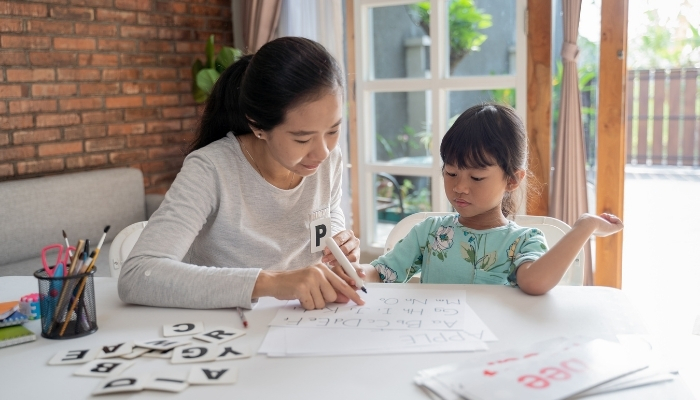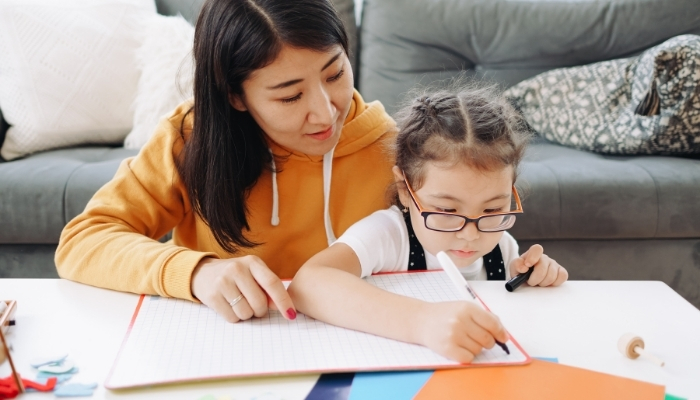Writing conventions might sound intimidating, but they’re really just the simple rules that help writing make sense. Your kindergartner is embarking on an exciting journey with letters and words, and these basic guidelines are the tools that will help them express their ideas clearly. Every letter they write and every creative spelling attempt is part of the learning process.
Think of it as planting seeds that will grow into strong writing habits. Your child doesn’t need to get everything perfect this year; what matters most is exploring, practicing, and discovering how writing works.
In this blog, you’ll learn about the key writing conventions your child will encounter, practical ways to teach them, fun activities to reinforce learning, and helpful tools to make writing both understandable and enjoyable. By the end, you’ll have a roadmap to support your child’s writing journey with confidence and creativity.
Key Takeaways
-
Kindergartners develop foundational writing skills through practice with letters, spacing, capitalization, punctuation, and phonetic spelling.
-
Gradual instruction and hands-on activities help children understand and apply writing conventions effectively.
-
Engaging exercises and meaningful writing opportunities strengthen confidence, creativity, and expression.
-
Using supportive tools and guided strategies reinforces skills while making learning enjoyable and accessible.
What is a Writing Convention?
A writing convention is a rule that helps make writing clear and easy to understand. These are the agreed-upon ways we organize letters, words, and sentences so readers can follow along.

Writing conventions include basics like starting sentences with capital letters, leaving spaces between words, and ending thoughts with periods. They're like road signs that guide you smoothly and clearly through your child's ideas.
Your kindergartner learns these conventions gradually through practice and gentle guidance. Just as they learned to balance before riding a bike, they'll build these writing skills one step at a time.
These conventions matter because they help your child share their wonderful thoughts with others. When writing follows these helpful rules, you can focus on your child's amazing ideas instead of trying to decode confusing text.
Understanding conventions early gives your child the confidence to express themselves freely. They'll feel more comfortable putting their thoughts on paper when they know these simple guidelines.
Key Writing Conventions for Kindergarten
Your kindergartner will encounter several essential writing conventions this year that form the foundation for all future writing success. These fundamental skills align perfectly with what most five and six-year-olds can handle developmentally.
Teachers introduce these concepts gradually, building on what your child already knows about letters and sounds.
Here are the core conventions your kindergartner will be introduced to:
Letter Formation and Handwriting Basics
Goal: Your child should be able to form uppercase and lowercase letters that are recognizable, with steady strokes and a proper pencil grip.
Letter formation is all about creating letters correctly. Your child learns to start at the top, move in the right direction, and make shapes that other people can read. You can think of it as teaching your child the steps to a handwriting dance.
Initially, letters may appear large, uneven, or messy. That is normal. With practice, letters will get smaller, neater, and easier to write. Forming letters correctly now helps your child write faster, read more easily, and understand how letters work.
Spacing Between Words
Goal: Your child should leave small, consistent gaps between words so each word stands out.
Spacing is more than just making the page look nice. It is the difference between “Ilovemydogmax” and “I love my dog Max.” Children often forget to pause between words because when they speak, words flow together naturally.
Expect some wobbles at first. Sometimes the gaps will be too wide. Sometimes they will forget spaces entirely. That is normal. Over time, your child will understand that spaces help readers, and themselves, make sense of their ideas.
Capitalization (Names and Sentence Beginnings)
Goal: Your child should capitalize their name and the first word in a sentence.
Capital letters tell readers that something important is starting. This includes names of people, pets, and places, as well as the beginnings of sentences.
Learning capitalization helps your child organize thoughts and write sentences that are easier to read and comprehend. Some children will forget occasionally, and that is completely normal. Reassure your child and yourself that this is a natural part of the learning process.
Punctuation (Periods and Question Marks)
Goal: Your child should end sentences with a period or a question mark.
Punctuation tells readers how sentences should sound when read aloud. Periods show the end of a thought. Question marks indicate that someone is asking a question.
Many children start by using punctuation correctly some of the time. Others might leave periods off or add question marks where they are not needed. This is normal. Learning punctuation now helps your child’s writing make sense and prepares them for more complex punctuation later.
Invented Spelling (Phonetic Attempts)
Goal: Your child should use phonetic spelling to write words as they sound.
Invented spelling allows children to write words by listening to the sounds and matching them with letters they recognize. Your child might write “luv” for “love” or “wuz” for “was.” This shows that they understand letters represent sounds and that writing carries meaning.
Multiple studies confirm that encouraging invented spelling fosters children's confidence and willingness to write. Encouraging this kind of spelling also sparks creativity and keeps children excited about writing. Mistakes are a sign of learning, and each attempt is a step forward.
Also Read: How to Help Your Child Struggling with Writing Skills
How to Teach Writing Conventions in Kindergarten?
Teaching writing conventions works best when you balance gentle instruction with plenty of hands-on practice opportunities. Your kindergartner learns most effectively through approaches that make abstract concepts feel concrete and meaningful.

Effective teaching combines showing your child how conventions work with guided practice and independent exploration time. Children need to see conventions in action, try them with support, and then experiment on their own.
The following methods work well whether you're a parent supporting learning at home or a teacher working with young students:
Modeling Writing
You demonstrate writing conventions by thinking out loud as you write. Show your child how you start with a capital letter, leave spaces between words, and add punctuation at the end.
This approach lets your child peek inside the writing process. They observe how you make decisions about conventions and hear your reasoning behind each choice you make.
Use simple sentences and everyday writing, such as grocery lists, thank-you notes, or weekend plans. Point out each convention naturally as you use it, explaining why it helps readers understand your message.
Shared Writing
In shared writing, you and your child will write together, taking turns adding words or sentences to create something meaningful. This partnership provides support while giving your child ownership of the writing process.
During shared writing, you can gently guide your child toward correct conventions while letting them contribute their creative ideas and some actual writing. This balance builds confidence alongside learning.
Try shared writing for birthday cards, imaginative stories, or plans for fun activities. Your child brings the ideas, while you help with conventions they haven't yet mastered.
Independent Practice
Your child needs regular chances to try conventions in their own writing. This can be achieved through personal journals, picture labeling, name practice, or creating simple stories about their interests.
Independent practice allows your child to experiment with conventions at their own comfortable pace. They'll make mistakes, but these attempts will provide valuable learning opportunities for both of you.
Provide various writing materials and meaningful purposes to keep independent practice engaging. Your child might write in a special journal, create bedroom door signs, or compose letters to grandparents.
Apart from the teaching methods, you can also try fun activities to make conventional learning memorable and enjoyable for your kindergartner.
Fun Activities to Reinforce Writing Conventions
Making writing conventions practice enjoyable keeps your kindergartner motivated and eager to learn more. Activity-based learning will transform abstract rules into hands-on experiences that children naturally remember and want to use again.

Select activities that align with your child's current interests and energy levels. Here are tried-and-true activities that make convention learning genuinely fun:
Label Everyday Objects
Creating labels for items around your home helps your child see that writing has meaning and connects words to real-life objects.
Try these steps:
-
Write labels for furniture like “Chair,” “Table,” or “Bookshelf.”
-
Label toys such as “Teddy Bear” or “Puzzle” and place them in bins.
-
Encourage your child to sound out letters in words like “Lamp” or “Sofa” and attempt their own spelling.
-
Display labels where your child can see and reference them.
-
Read the labels together during daily routines.
Popsicle Stick Spacing Game
This game helps children understand that words are separate units, making the spacing between them tangible.
Try these steps:
-
Place a popsicle stick between words in a sentence like “I love pizza.”
-
Practice with sentences about favorite activities, for example: “We play outside.”
-
Gradually remove the popsicle stick as spacing becomes natural.
-
Use magnetic letters with a small object between words to reinforce spacing.
-
Turn it into a “spacing detective” game by finding sentences that need spacing fixes in storybooks.
Fix the Silly Sentence
Children correct sentences with missing capitals, punctuation, or spacing. This strengthens editing skills while reinforcing writing conventions.
Try these steps:
-
Correct sentences like “my cat is orange” by capitalizing the first letter.
-
Add missing periods in sentences like “We went to the park.”
-
Separate words in run-together sentences, such as “Ihavetwodogs.”
-
Use different-colored pencils for different corrections, for instance, red for capital letters, and blue for punctuation.
-
Let your child create a silly sentence for you to fix together.
Writing Letters and Cards
Opportunities for meaningful writing motivate children to use conventions carefully and enjoy the process.
Try these steps:
-
Write short letters to a favorite book character: “Dear Peter Rabbit, I like your garden.”
-
Make greeting cards for neighbors or friends: “Happy Birthday, Liam! Hope you have a fun day.”
-
Compose simple letters to siblings or classmates: “I like playing with you. Do you want to play tomorrow?”
-
Create seasonal cards: “Happy Halloween! Enjoy the candy.”
-
Have your child sign their name, checking letter formation and capitalization.
Story Picture Books
Children combine drawings and writing to create small books, encouraging expression while practicing conventions.
Try these steps:
-
Fold 4–6 sheets of paper to make a small book.
-
Encourage one sentence per page, e.g., “I have a red ball.”
-
Offer letter formation guidance only when requested.
-
Allow invented spelling naturally, like “bll” for “ball.”
-
Display completed books on a special bookshelf for reading aloud.
Name Writing Practice
Focusing on personal names makes writing meaningful and naturally motivating.
Try these steps:
-
Write names in sand, salt, or finger paint, e.g., “Samantha.”
-
Make puzzles with letter cards to spell names.
-
Practice writing names with chalk, crayons, or markers.
-
Include family member or pet names: “Mom,” “Dad,” “Fluffy.”
-
Use name writing for labeling artwork or personal items.
Punctuation Detective Adventures
Children hunt for punctuation in books, signs, and environmental print. It makes learning interactive and reinforces sentence conventions.
Try these steps:
-
Give your child a magnifying glass to find periods, question marks, and capitals.
-
Track punctuation discoveries on a simple chart.
-
Discuss why authors chose punctuation marks in different contexts.
-
Look for punctuation in signs like “Stop” or “No Parking.”
-
Celebrate discoveries with stickers or stamps.
Letter Formation Songs and Chants
Music and rhythm help children remember how to form letters correctly, making practice enjoyable.
Try these steps:
-
Find commercial letter formation songs or create simple family versions.
-
Act out letter formations using large arm and body movements.
-
Sing while writing letters in the air or on paper simultaneously.
-
Create specific movements that correspond to the starting points and directions of the letters.
-
Practice challenging letters with personalized songs or memorable chants.
These activities work most effectively when you participate alongside your child, offering gentle encouragement and support without taking control of their creative process.
Also Read: Best Creative Writing Tools for Kids in 2025
Helpful Tools and Resources to Reinforce Writing Conventions
The right tools can make learning writing conventions significantly easier and more engaging for your kindergartner. Utilizing additional resources offers visual support and hands-on practice opportunities that reinforce what children learn in school.

Here is a list of resources you can choose from:
-
Alphabet strips and name cards: Keep these within reach at your child’s writing spot. They’re great for quick reminders about letter formation and capitalization while your child writes independently.
-
Writing mats with guidelines: These help your child see how big letters should be and where they belong on the lines. Many mats even have starting dots or picture cues to guide correct strokes.
-
Punctuation charts with examples: Hang a chart that shows periods, question marks, and exclamation points with simple sentences or pictures. Your child can glance at it when they’re unsure.
-
Letter formation guides with arrows: Step-by-step guides that use numbers and arrows make forming letters much clearer. Your child can follow along at their own pace.
-
Physical spacing tools: Popsicle sticks, small counting bears, or finger spacers can help your child leave the correct gaps between words. Making spacing tangible in this way often resonates more effectively than simply explaining it.
-
Free printable worksheets and activities: Look for ones that focus on one skill at a time. Fun themes or familiar characters keep your child engaged without feeling overwhelmed.
-
Special writing journals and books: Dedicated notebooks give your child space to practice letters, words, and sentences in a meaningful way. Select journals with wide margins and ample space for pictures, as well.
-
Magnetic letters and whiteboards: These let your child build words and sentences hands-on without worrying about pencil control. They can focus entirely on spacing and capitalization.
-
Small dry-erase boards and colorful markers: Mistakes are no problem here; everything erases easily, which encourages experimentation and confidence. Quick practice sessions or games work really well with these.
-
Letter and punctuation stamp sets: Stamps make writing conventions playful. Your child can create words and sentences while practicing correct spacing and punctuation.
-
Simple timer for short writing sessions: Short bursts, like five minutes, help your child build stamina without feeling pressured. Gradually increase the time as they grow more comfortable.
Adding these tools will make abiding by writing conventions more joyful for the kids. However, these tools work most effectively when combined with expert guidance and structured instruction that builds systematically on your child's naturally developing skills.
How Can the FunFox Writers Club Help?
The FunFox Writers Club offers a comprehensive approach to developing writing conventions through engaging, developmentally appropriate instruction. Our program combines expert teaching with creative activities that make learning conventions feel enjoyable rather than overwhelming.

Funfox's structured approach provides your child with focused, high-quality instruction that boosts their learning potential.
Here's specifically how our program supports writing convention development for your kindergartner:
-
Expert-guided instruction: Our carefully trained teachers understand child development stages and use proven methods to introduce conventions gradually and naturally. They know exactly when to challenge students and when to provide additional gentle support.
-
Interactive learning activities: We transform conventional learning into engaging games, creative projects, and hands-on activities that help important concepts stick permanently. Children practice spacing through storytelling adventures and punctuation through character-based activities.
-
Regular feedback and encouragement: Teachers provide immediate positive feedback during activities and offer thoughtful written comments that gently guide improvement.
-
Small group learning dynamics: With a maximum of six students per class, every child receives individual attention while benefiting from positive peer interaction. Students learn naturally from each other's questions and discoveries.
-
Strong home-school connection: We provide practical resources and specific suggestions to help parents support conventional learning at home.
-
Flexible online learning format: Students can participate comfortably from anywhere while accessing recorded sessions for helpful review.
Additionally, the Writers Club creates a nurturing environment where learning writing conventions feels natural and exciting.
Wrapping Up
Learning the basics of writing gives your child the confidence to express themselves and share their ideas clearly. Introducing writing conventions to kindergartners in playful, meaningful ways helps them understand how letters, words, and punctuation work together, while keeping the process enjoyable.
When practice is engaging and supportive, children develop skills naturally, without pressure, and start to enjoy writing as a way to explore their creativity. The FunFox Writers Club takes this further by blending expert guidance with hands-on, imaginative activities that make learning conventions feel effortless and exciting.
Give your child the chance to build strong writing habits early and watch their confidence grow with every word they write. Book a trial today and see how enjoyable and rewarding early writing can be.
FAQ’s
1. What should a 5-year-old's writing be like?
A 5-year-old’s writing typically includes recognizable letters, basic words, simple sentences, and early attempts at spacing, capitalization, and punctuation. Invented spelling is common, reflecting sound awareness and the development of fine motor skills.
2. What are the different writing styles for kindergarten?
Kindergarten writing styles include narrative (telling stories), descriptive (sharing details), informational (explaining ideas), and opinion (expressing likes or dislikes). Children experiment with combining words and pictures to communicate meaning effectively.
3. What is the writing process for kindergarten?
Kindergarten writing often follows a sequence: brainstorming ideas, drawing or planning, writing words and sentences, revising with guidance, and sharing work. Practice is gradual, playful, and focused on expression and understanding.
4. What are the 7 teaching principles of writing?
The seven principles include modeling, guided practice, independent writing, authentic purposes, developmentally appropriate expectations, feedback and encouragement, and integration of reading, speaking, and listening skills to support writing growth.















